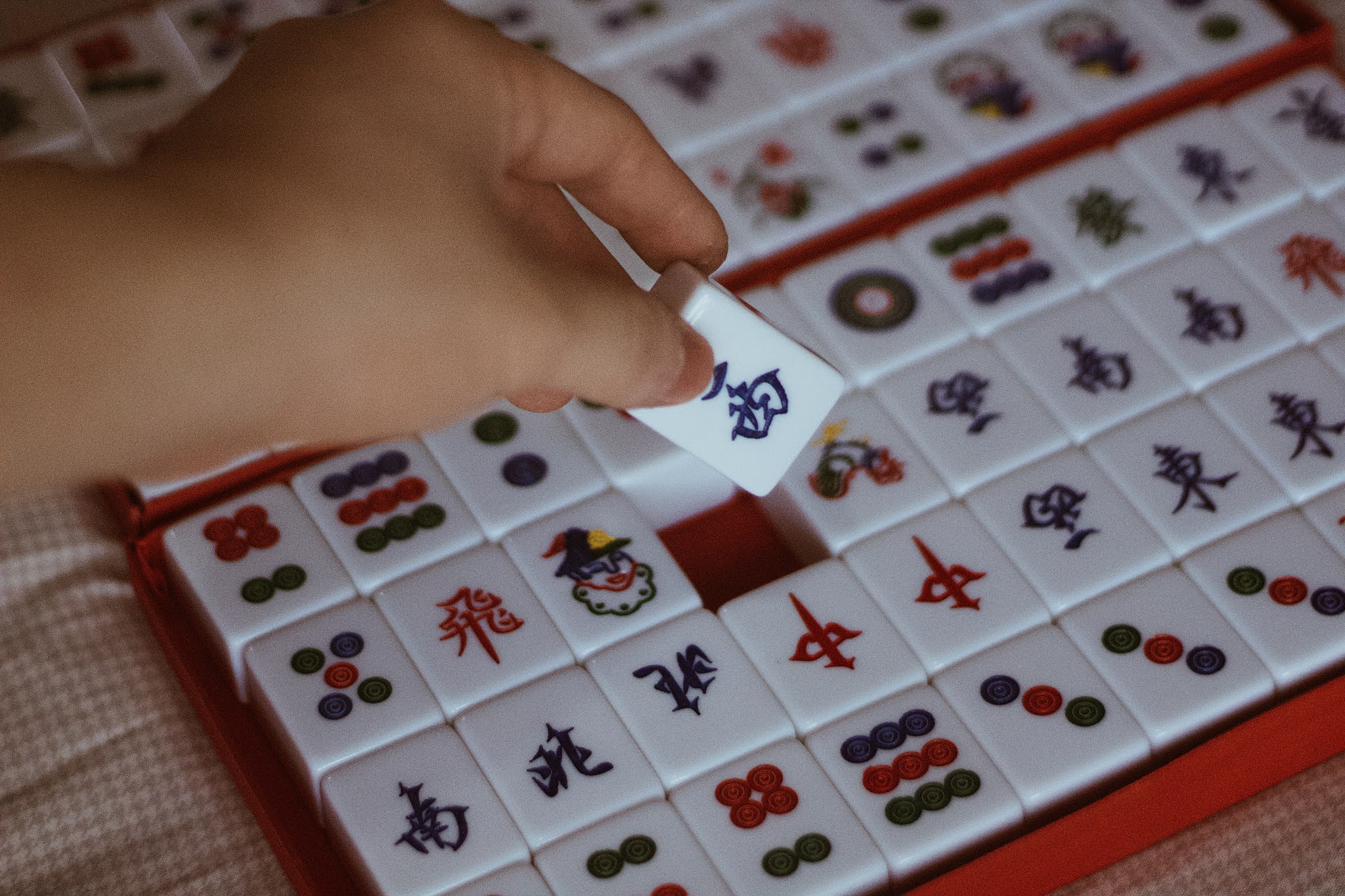A letter from Mahjong Expertise | By Pui Yein
Most people remember themselves playing with Legos, building brick castles or towers at ages five or six. Well, I played with something different: Mahjong tiles!
Someone yells, “Open table!”, and four people huddle around the square wooden table. Each takes their turn grabbing and discarding tiles from the diamond-shaped Mahjong tile stack. Onlookers stand around them, peeking over the shoulders of their competitors with a handful of sunflower seeds and nuts. The click-clacking of shuffled tiles mingles with exclamations of “Peng” (taking opponents’ discarded tiles to form three identical ones), “Chow” (taking opponents’ discarded tiles to form a sequence of three tiles) and “Sik hu” (I win!) leaves you with no room for conversation. This is the wonderful game of Mahjong.
 |
| Photo by Tsang Ching Nam. |
Growing up in a Chinese household, this was a common sight to behold at family celebrations, parties, and gatherings. Mahjong is a tile-based game developed in 19th century China and is often referred to as China’s ‘national pastime’. It has spread throughout the world since the early 20th century. To have a winning hand, the fourteen tiles must consist of four melds and a pair. A meld can be achieved by having exactly three identical tiles or a sequence of three tiles.
As a child, I was always intrigued by how strategy, skill, calculations, and luck intertwine to result in a Mahjong victory. As a seasoned player myself, not only have I been surprised by the skills I’ve acquired, but also the philosophies contained in Mahjong. I realized that the game contains many secrets to life’s conundrums. If you know how to play and master the game, you’ll have a better understanding of the relationship between chance and necessity. Even if you have the worst hand, with your strategical and methodical skills, weakness will become strength; worst will become the best. This is what I learned amidst my peng, sik wu, wins and losses. I would say it is easy to learn the basics, but the game is indeed hard to master. So before I dole out some insider Mahjong tips for you, here are some fun facts about the game!
Fact #1: Mahjong was originally a card game played by fishermen.
A thousand years ago, on a sunny day in China, a group of sailors came up with a card game to distract themselves from the hardships of life at sea. This is how Mahjong was born.
Fact #2: In 1949, Mahjong was banned in China by the regime.
 |
| Photo by Tsang Ching Nam. |
Not all people took to Mahjong positively. The game is often regarded as an inferior pastime for idlers and a sign of over-indulgence and gambling. It was even banned in 1949 by the People’s Republic of China, who declared it to be outlawed along with other gambling activities. However, even with the negative connotations, Mahjong still had a firm hold on the hearts of the people. It was reintroduced after the Cultural Revolution ended in 1976 and people started to play it openly again.
Fact #3: The name “Mahjong” translates to “sparrow” in Mandarin
Have you ever heard a sparrow chirp? Some think that the name “Mahjong” was given because the clicking sound of the tiles is similar to the chirping of a sparrow. However, some also speculate that the speed of the players’ movement is like that of a sparrow—hopping around nimbly in their light bodies.
Fact #4: The most luxurious mahjong set ever made is covered with hundreds of diamonds and rubies
The world’s most expensive Mahjong set is worth $1.3 million, equivalent to RM5.5 million. 26,000 normal sets of mahjong can be bought with this amount of money. Each tile of the expensive mahjong set is specially handcrafted with a combination of a few luxury materials: solid blocks of Tanzanian ruby, gold vermeil, Burmese rubies, and diamonds.
Since this is a beginner’s handbook, here are some ‘insider strategies’ that you can use so that you don’t flop your first Mahjong game. You may even pass as an advanced player if you do it right!
Mistake #1: Blindly grabbing discarded tiles
 |
| A still from the film Crazy Rich Asians. Source: Head Topics. |
Every move is critical as it pretty much reflects your game plan for the round. Remember to not blindly grab the discarded tiles without thinking. You must keep in mind that every opponent at the Mahjong table is observant, and all the tiles you grab from the discarded area have previously been exposed. The more you grab from the disposal area, the easier your opponent can read you.
Mistake #2: Having gaps between your tiles
Trust me, I’ve tried that too! By doing this, you’re giving your opponent a chance to guess your next moves. The most common mistake that a beginner makes is arranging their tiles according to the sets they have and leaving gaps between the sets. Opponents can easily make a guess and adjust their strategies accordingly.
Instead, you should rearrange your tiles of the same pattern into groups of chow, peng, and gong on the left of the line and the rest on your right. This will give you a clear view of the sets that you have and the tiles you need. Pro tip: leave random gaps between tiles to confuse your opponent.
Mistake #3: Making a clumsy move
 |
| Photo by Tsang Ching Nam. |
People tend to get excited or anxious whenever they hear people shouting for gong and peng. Your every move reflects the tiles on your hand; opponents can easily guess your tiles by looking at those that you’ve thrown. The main strategy is to plan every move. Remember: every small action matters. Another pro tip: just because other players get the gong and peng doesn’t mean that they’re winning the game. Don’t get distracted by others. Take your time and just have fun. If you become more advanced in the future, you can also use this strategy to bluff your opponents!
Most importantly, remember to have fun! This game is supposed to encourage bonding between players, so just take it easy and enjoy the moment. Like I said, Mahjong takes a few minutes to learn, but a lifetime to master. The value of Mahjong deserves to be recognised and explored over every generation so that the culture can endure forever.







0 comments